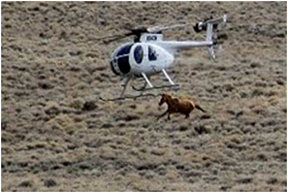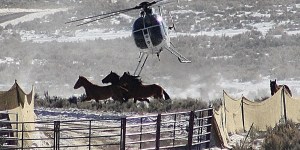Press Release from Grass Roots Horse
Pilot Flips Off Public Outcry
On Feb, 6th at the Bureau of Land Management’s wild horse roundup and removal in Antelope Complex, Elko district, NV the blatant abuse of wild horses by helicopter continues after the BLM reprimands the pilot.The pilot spent Super Bowl Sunday thumbing his nose at the alleged warning he received,” journalist Laura Leigh stated “this man was saying I can do as I darn well please.” In a quote from the BLM’s Washington DC spokesmen, Tom Gorey when asked to comment on other shocking photos taken by Laura Leigh on Monday January 31, 2011 after the so called reprimand was issued to the pilot. “BLM believes the photos were taken the same day of the video but from a different angle”. Tom Gorey is referring to videos depicting the helicopter abuse of an old horse taken on January 27, 2011 by two other observers. The photos taken by Leigh on January 31, 2011 just days after the BLM’s alleged reprimand are meta tagged with the date January 31 and time as well as the fact that Laura Leigh was not present at the roundup on January 27, the date that the video Tom Gorey refers to was shot.
“I literally feel ill. I always suspected what was happening behind the rises I could never see beyond. Now I know and reviewing pictures and video, reliving this, literally makes me ill. After the pilot’s been given the warning yet the behavior continues. What can we the public expect the reactions of the Obama administration to be in addressing this serious issue” Laura Leigh stated. Over 2,000 frames were shot today demonstrating this type of action by this pilot.
The ability of observers to capture these images and finally inform the public of what is happening to our wild horse herds has been assured by the legal action taken by Grass Roots Horse. The Elko district attempted to close public lands during the Owyhee roundup and obstructed the public’s ability to witness a single horse rounded up from Owyhee and Grass Roots Horse continues to make a stand for the public’s right to know. http://grassrootshorse.com
__________________________________________________
Also:
Recognized Wild Horse Expert Adds More To Obama's Dunce List
A Continuation of Craig Downer’s Open Letter to the BLM~ Click (HERE) for first installment
BLM’s Lack of Equine Understanding is Stunning
Feb. 6, 2011BLM Ely District Office (Nevada)
Attn: Gary W. Medlyn, Egan Field Manager
re: DOI-BLM-NV-L010-2011-0004-EA (2nd input)
Dear Sirs:
I sent you an email input on Jan. 30th of this year and would like to add the following input:
On page 23 of your document you paint a very rosy picture of the results of the roundup, but in fact overlook many positive aspects of leaving the wild horses alone. You mention that the rate of foaling will increase after the roundup. Yes, I agree, but is this not what you want to prevent by allowing the herds to self-stabilize? They do self-stabilize if allowed to fill their niche. I suggest you look into natural boundaries, predators, buffer zones, etc., as part of an effective Reserve Design concept.
I would like to add that by over-reducing the herd, you set back the natural adaptive process, that I so appreciate as a biologist. This occurs between the wild horses and the ecosystem they inhabit. Part of this is that by removing the mature horses, you disrupt the social and ecological order. These older horses have had more time to attune themselves to the natural life community where they live and they guide the younger ones, prevent too early reproduction, and lead the bands in their seasonal migrations up elevation in the warmer seasons and down elevations in the colder seasons. They perform a natural rest rotation of grazing pressure on forage when fences do not prevent them from doing so. So my question to you is: are you taking into full account all these natural factors that you should when providing for a integrated wild-horse-containing ecosystem that provides for a truly long-term genetically viable population? And is this in harmony with the true intent of the Wild Free Roaming Horses and Burros Act of 1971? I protest your overly low AML (see earlier input) and your skewed sex ratios and PZP’ed mares and favor a Reserve Design concept for the attainment of self-stabilizing herds, in conjunction with a fairer allocation of forage for the wild horses, meaning less given to livestock and more to the wild horses who by law should be treated as the principal presences within their legal herd areas or herd management areas (BLM) or territories (USFS).
On page 24, you mention those older or infirm horses that will be targeted for euthanasia. Here I would just like to make two points: Would it not be much fairer and more in tune with the WFRHBA were you to allow the natural life cycles to complete themselves in the wild, rather than subjecting these horses, who have managed to survive, obviously, up unto the point of gather, to a very stressful and anguishing jerking out of their natural home and band and herd companionship and placing in the artificial confines of a corral and its truly overcrowded conditions compared with what they are used to? By allowing them to contribute their remains to the natural world and its food web when they die, you would be in true conformance with the WFRHBA, which stresses that they are to be regarded as natural components of the federal lands ecosystems and minimally interfered with.
Also on page 24, you mention that only 0.5% of the horses gathered die in the gather operation. This is a misleading statistic that does not account for the much larger percentage that later dies during the processing, short-term holding and long term holding. This is usually ca. 5% or more, judging from the Calico Complex wild horse roundups that occurred during the first months of 2010 and their attrition at the Broken Arrow private short term holding facility north of Fallon.
Sincerely,
Craig C. Downer, Wildlife Ecologist











No comments:
Post a Comment